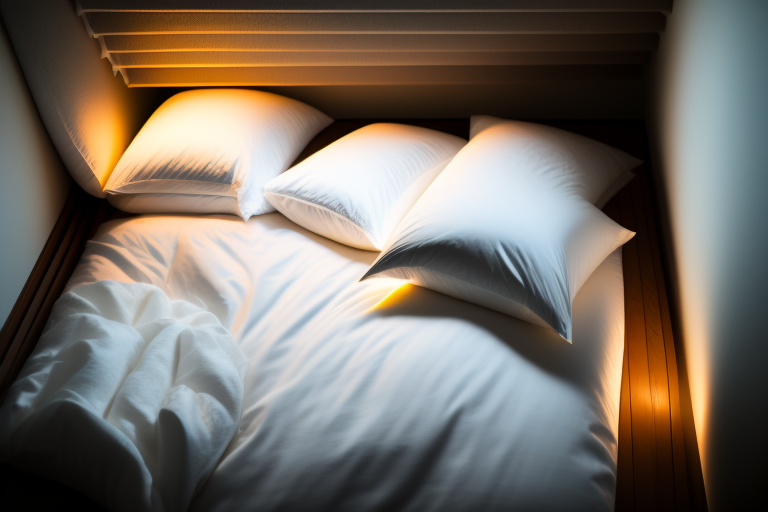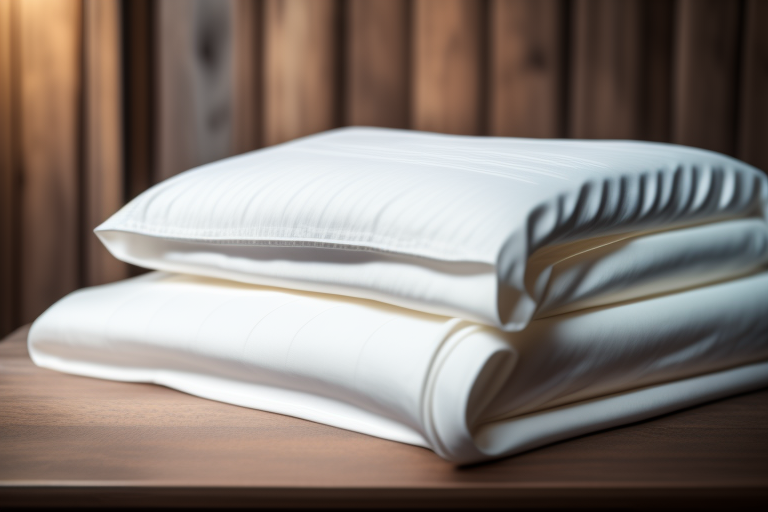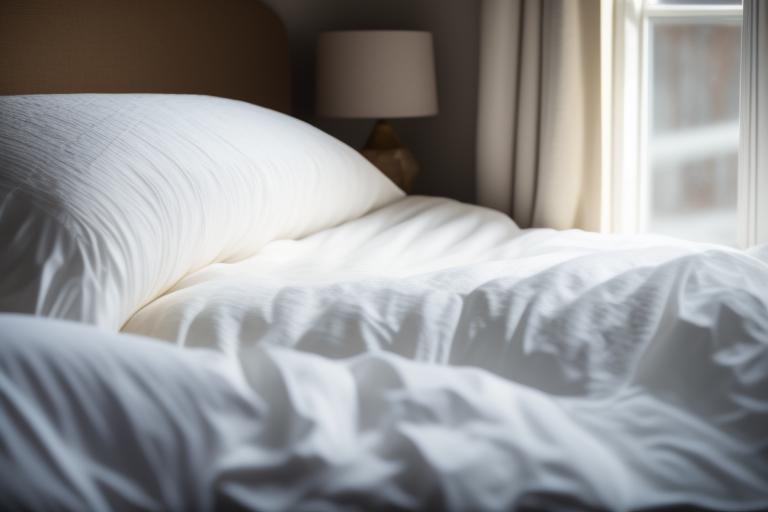Do you ever wonder just how often you should be washing your bed sheets? While it may seem like a mundane household chore, regularly washing and changing your bedding is an important part of maintaining good hygiene and ensuring you have a clean sleeping environment.
In this beginner’s guide, we’ll walk through the basics of bedding care and laundering. We’ll look at the factors that impact how frequently you should wash your sheets, best practices for cleaning them properly, and tips for keeping your bedding fresh between washes.
Why Is Bedding Hygiene Important?
Before we dive into the logistics, let’s look at why bedding hygiene matters in the first place:
- Promotes good health: Clean bedding helps prevent the transfer of dirt, germs, and bacteria that can lead to illness. This is especially important for those with allergies or compromised immune systems.
- Avoids skin irritation: Dirty sheets collect dead skin cells, sweat, oils, and other debris that can clog pores and cause acne breakouts or rashes.
- Improves sleep quality: Soiled linens don’t allow for as comfortable and restful sleep compared to fresh, clean bedding.
- Extends lifespan of bedding: Regular washing preserves the quality and appearance of sheets, pillowcases and comforters.
Now that we’ve covered the main benefits of washing bedding routinely, let’s look at some guidelines for how often to realistically wash everything.
Recommended Laundering Frequency For Bedding
Here are the typical recommendations from cleaning experts on how often you should aim to wash different bedding items:
- Sheets: Every 1-2 weeks
- Pillowcases: Every 1-2 weeks
- Comforters: Every 6 months
- Duvet covers: Every 2 weeks
- Blankets: Every 3-4 months
- Mattress pads: Every 1-2 weeks
- Dust ruffles/bedskirts: Every 2-3 months
Of course, these laundry frequencies are simply guidelines – the actual ideal timing for washing your bedding depends on several factors:
Factors That Impact Bedding Laundry Frequency
- Hot and humid climates: More frequent washing needed to prevent musty smells or mildew growth from sweat.
- Presence of pets or small children: Higher amounts of dirt, soil and organic debris.
- Health conditions: Those with asthma or allergies may need to wash more frequently.
- ** Frequency of use:** Guest room sheets may not need washing as often.
- Makeup wearers: Cosmetic stains and oils can build up more quickly.
- Exercising in bed: Fitness trackers in bed can increase dirt and bacteria.
Now that we’ve covered the basics on bedding washing frequency, let’s go over the laundering process step-by-step.
Preparing Bedding For Washing
Before you can wash your sheets, pillowcases, and other linens, you’ll need to properly prepare the items:
- Remove pillowcases and shams: Check that all pillows have been removed before washing pillow shams or pillowcases. Zip up any comforters or duvets to prevent interior bunching.
- Check care labels: Look at the care instructions sewn into bedding to see if there are any special washing guidelines. Note symbols for bleach, dryer heating, ironing and more.
- Treat stains: Use a stain remover stick or spray to pretreat any visible stains prior to washing. This can prevent them from setting in.
- Wash bed bug protection: If using a bed bug mattress encasement, wash separately from other linens. Use hot water and dry on high heat.
Choosing Wash Cycles, Detergents, and More
- Water temperature: Warm or hot water helps kill germs and allergens. Cold water can be used for bright or darks prone to fading.
- Wash cycle: A normal cycle is fine for most bedding. Use a gentle/delicate cycle for silk or satin items.
- Detergents: Look for an unscented and hypoallergenic formula. Liquid detergents can work best for removing body oils and dirt.
- Bleach: While not required, adding 1⁄2 cup of bleach to the wash can help kill germs and whiten sheets. Check care labels first.
- Drying: For most bedding, tumble dry using medium or high heat to kill dust mites. Air dry for delicate fabrics.

Special Considerations For Sheet Types
The fabric composition of your sheets impacts both how frequently they need laundering and what washing methods should be used. Here’s a quick overview:
Cotton
- Benefits: Soft, breathable, absorbent and easy to wash.
- Wash Frequency: Every 1-2 weeks.
- Care Tips: Durable enough for hot water and high heat drying.
Linen
- Benefits: Strong, antimicrobial and gets softer over time.
- Wash Frequency: Every 2-4 weeks.
- Care Tips: Wash in cold water on gentle cycle. Line dry or dry on low.
Polyester
- Benefits: Wrinkle-resistant and quick drying.
- Wash Frequency: Every 2-3 weeks.
- Care Tips: Wash in warm water. Medium heat drying.
Silk
- Benefits: Extremely soft and smooth.
- Wash Frequency: Every 2-4 weeks if possible.
- Care Tips: Hand wash or delicate cycle only. Line dry or lay flat to dry.
Making Your Sheets Last Longer Between Washes
If you don’t have the time or want to wash sheets more than every couple weeks, there are tips to help them stay fresher longer:
- Make your bed daily: Pulling sheets tight helps moisture evaporate.
- Air out sheets: On sunny days, open windows so sheets get fresh airflow.
- Use mattress pads: These absorb body oils and sweat between sheet washes.
- Rotate sets: Having 2-3 sheet/pillowcase sets makes rotating easier.
- Spot clean stains: Use a damp cloth to wipe up new spills and stains.
Signs It’s Time To Wash Bed Sheets
While following standard wash frequency recommendations is useful, also watch for these signs it’s definitely time to wash bedding:
- Visible stains from dirt, makeup, sweat, etc.
- Sheets feel stiff, crunchy or rough
- Pillowcases lead to skin irritation or acne
- You can see pet hair, dander or dust on sheets
- Sheets have an unpleasant odor
- Last wash date is unknown or over 3 weeks ago
- You’ve been sick recently in bed
Bedding Care Dos and Don’ts
To keep your sheets in the best condition possible, keep these laundry dos and don’ts in mind:
Do:
- Check all zippers are fully closed.
- Wash bed bug protectors separately.
- Use scent and dye-free detergent.
- Untangle sheets before drying.
- Change mattress pads as needed.
Don’t:
- Overload the washing machine.
- Use harsh bleach without checking.
- Dry clean comforters and duvets.
- Wash deliate fabrics on hot.
- Leave damp sheets balled up.
The Impact of Your Washing Machine
Your washing machine settings and features also factor into the sheet washing process. Here are considerations around your washer itself:
- Capacity: Make sure not to overload washers, as sheets need room to move and rinse fully.
- Cycle options: Look for bedding or allergen-specific cycles designed to deeply clean linens.
- Efficiency: High-Efficiency (HE) detergent prevents oversudsing and works best for HE machines.
- Maintenance: Regularly wipe out the washer interior and run cleaning cycles to prevent mold.
- Age: Older washers may not wash linens as thoroughly. Newer models also tend to use less water.
Best Practices For Laundry Hygiene
Washing your sheets helps keep them clean, but you also need to ensure good laundry hygiene habits overall:
- Wash sheets separately from towels and dirty clothes.
- Use separate hampers for clean vs. dirty laundry.
- Don’t leave sheets balled up wet for too long before drying.
- Disinfect the washing machine monthly.
- Immediately wash new sheets before use.
- Don’t let laundry sit damp for over 2 days before drying.

Eco-Friendly Laundry Tips
For those concerned about the environmental impact of frequent laundry, try these tips:
- Wash sheets in cold water whenever possible.
- Only run full loads instead of small washes.
- Choose an ENERGY STAR certified washing machine.
- Opt for concentrated liquid detergents instead of powders.
- Use dryer balls instead of fabric softener sheets.
- Hang-dry sheets and bedding when you can.
Top Sheet and Pillowcase Picks
If you’re in the market for new bed sheets, these highly rated options provide quality and value:
Budget Pick
Utopia Bedding Brushed Microfiber Sheet Set
- $25 for queen
- Soft, cozy microfiber
- Wrinkle and fade resistant
Mid-Range Pick
Mellanni Brushed Microfiber Sheets
- $35 queen set
- Silky soft feel
- Available in 40+ colors
Luxury Pick
Brooklinen Luxe Core Sheet Set
- $175 for queen set
- 480 thread count
- Hotel-level quality
Best Pillowcases
- $24 for set of 2
- 100% mulberry silk
- Helps prevent hair breakage
In Summary
While washing sheets weekly or bi-weekly may seem like overkill, regularly laundering bedding is a worthwhile endeavor for your health, hygiene, and sleep comfort. Focus on these main takeaways:
- Wash sheets at least every 2 weeks for most people
- Choose the right wash method for the fabric
- Dry thoroughly to kill dust mites
- Watch for visible signs it’s time for a wash
- Rotate between multiple sheet sets
- Maintain laundry hygiene throughout the process
With these tips, you can rest assured knowing your bedding will provide a fresh and clean sleep environment night after night. The extra time invested in laundering will pay off in better rest and minimized allergy symptoms.
Still have questions about keeping sheets clean? Let us know in the comments!
Frequently Asked Questions
What are the best bedding materials to buy?
The most popular bed sheet materials are cotton, microfiber, linen, polyester, and silk. Cotton sheets are very soft and breathable. Microfiber sheets are affordable, durable, and wrinkle-resistant. Linen sheets are temperature regulating and get softer over time. Polyester sheets dry quickly and minimize ironing. Finally, silk sheets feel luxurious and smooth against skin. Consider your budget, climate, and laundering needs when choosing sheets.
How do I get rid of yellow stains and discoloration on sheets?
To help whiten sheets and remove yellow stains or dinginess, wash bedding in hot water using an oxygen based bleach alternative or non-chlorine whitener. For tough stains, let sheets soak before washing. You can also occasionally wash sheets with 1⁄2 cup of traditional bleach – just check the care label first.
Can I wash memory foam pillows?
No, memory foam pillows should not be machine washed as it will damage the foam interior. To freshen up memory foam pillows, spot clean stains with a damp towel and mild detergent. You can also sanitize them with a spray disinfectant. The pillow covers can be removed and machine washed regularly.
How do I add fragrance to sheets naturally?
To lightly scent sheets, you can use wool dryer balls soaked in your favorite essential oil. You can also spritz sheets lightly with an essential oil dilution before making your bed. Or add a few drops of essential oil right to your liquid laundry detergent. Just don’t overdo the fragrance to avoid skin irritation or allergies.
Can I just use very hot water to sanitize sheets instead of bleach?
Washing sheets in hot water, around 140°F, can help kill bacteria without using harsh bleach. However, many experts recommend occasionally washing bedding with a small amount of bleach to fully disinfect – especially if someone has been sick. Check the care label and never mix bleach with ammonia. Proper drying and ironing will also help kill germs.








